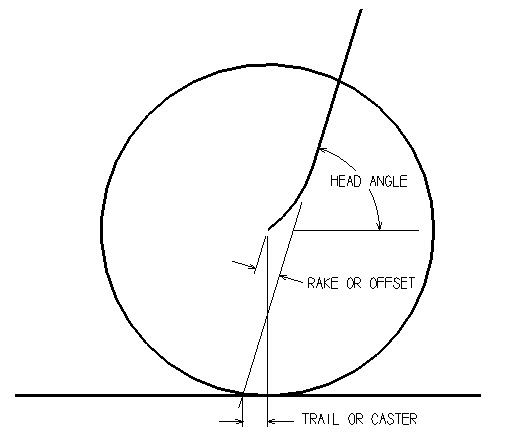Understanding Bike Frame Geometry
by Daniel Dyla
Frames are a frequently misunderstood part of buying a bike. There are tons of measurements and nobody seems to know what they all do. If I tell you a bike has a 625mm effective top tube, 38.1mm rake, 71.0 head tube angle, 423mm chainstay, and 74mm trail, would you be able to tell me the handling characteristics of that bike? I thought not. The simple truth is that nobody really can. Some people know more about what each of these measurements mean than others, but the only way to know for sure how a bike is going to ride is to ride it. That being said, there are a few simple things to look for when looking for a bike frame.
Trail
Trail is frequently quoted as being the composite of the rake and head tube angle. It’s ok, I didn’t really know what that means either. The easier way to think of it is the amount that the wheel “trails” behind the forks.

A general rule of thumb is that a large trail will give you more high speed stability but will not allow tight cornering. A short trail will allow more responsive turning at the expense of stability. A lot of manufacturers don’t give trail as a measurement but instead give you only angle and rake. Using angle and rake, trail can be calculated using a calculator.
- Long trail gives high speed stability
- Short trail allows more agility
Bottom Bracket Height
The bottom bracket height mostly affects stability and balance. A lower bottom bracket means a lower center of gravity and a more stable riding position. The tradeoff is that a bottom bracket that is too low can cause issues with ground clearance and pedals may hit the ground in turns. Bottom bracket height comes down to preference. Some riders like a lower 12” bracket because they like the low center of gravity, while others want 13.5” because they want to be able to pedal through turns without worrying about hitting the ground.
- Low bottom bracket is more stable
- High bottom bracket gives more obstacle clearance
Chainstay length
The effect of the chainstay length is one of the most important factors when talking about the characteristics of a bike frame. Chainstay length affects the weight distribution, wheelbase, and rigidity of a bike frame.
Proper weight distribution will cause the rider to feel more stable on downhills, and faster on uphills because the rear tire won’t slip and the front tire will stay solidly connected to the ground. Longer chainstays allow the rider to put weight on the rear tire without fear of the front tire lifting off the ground. A chainstay that is too long, however, will make it difficult to put enough weight on the rear tire and allow it to slip.
Chainstays most obviously affects wheelbase. A longer wheelbase will feel more stable, especially at high speeds. A short wheelbase will feel lighter and more agile in techinical turning sections. This is really up to the preference of the rider.
The final thing a chainstay affects is rigidity. A more rigid chainstay will more efficiently transfer energy from the pedals to the ground. Generally, shorter chainstays are more rigid. Long chainstays have more leverage and flex more, absorbing more energy. These days, materials exist to allow for long chainstays that are still very rigid, however this will make them heavier and more expensive.
- Long chainstays allow more stability and faster climbing
- Short chainstays allow faster turning and more rigid frames
Subscribe via RSS
